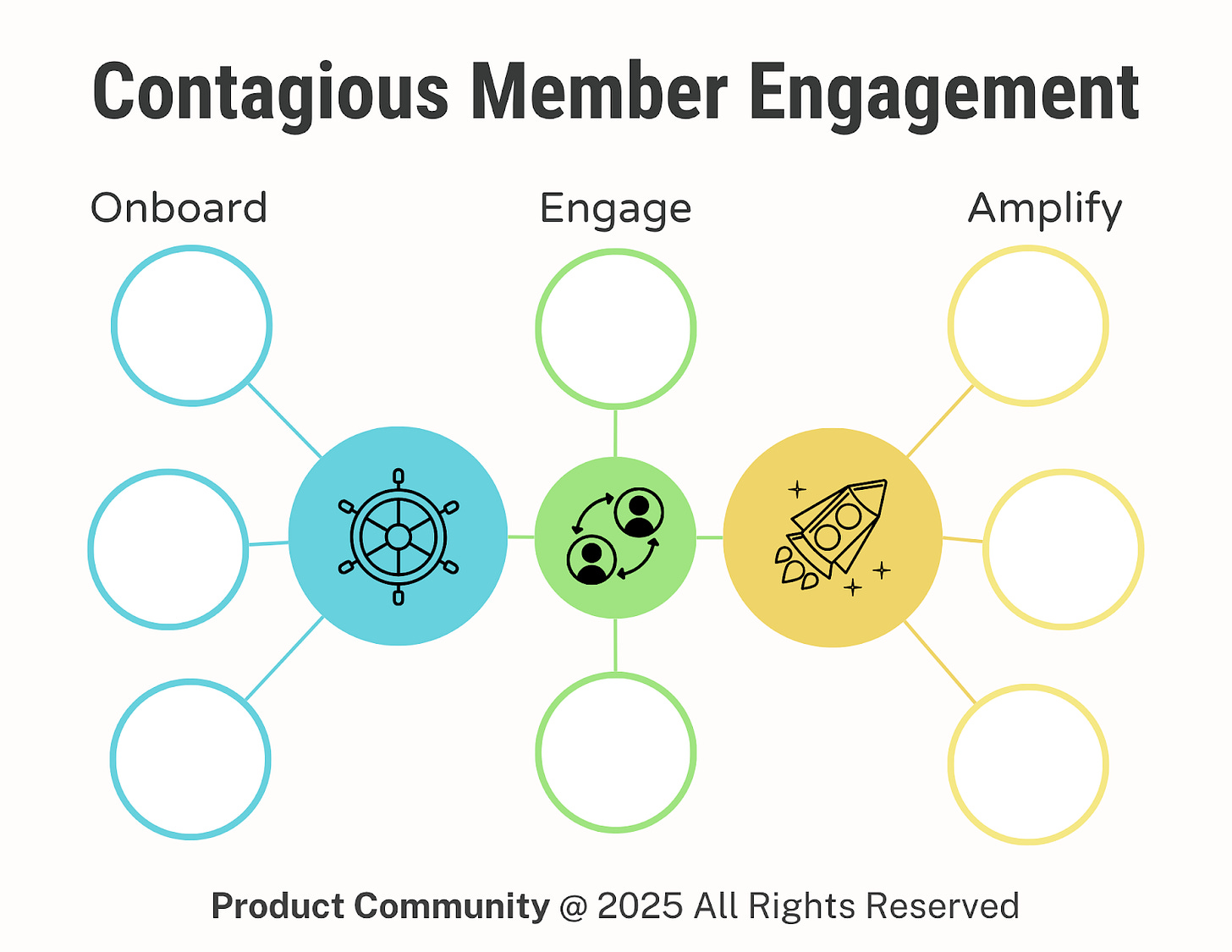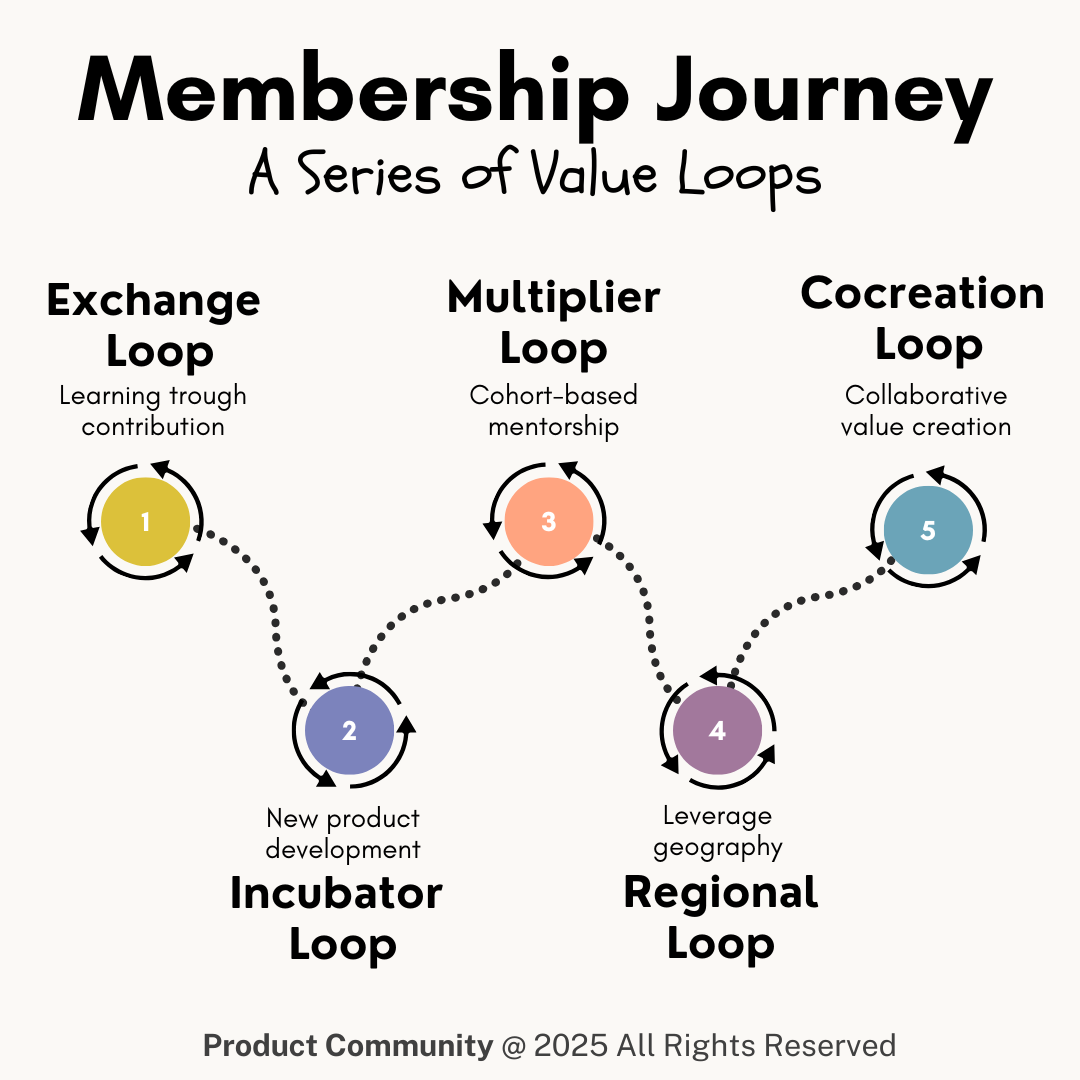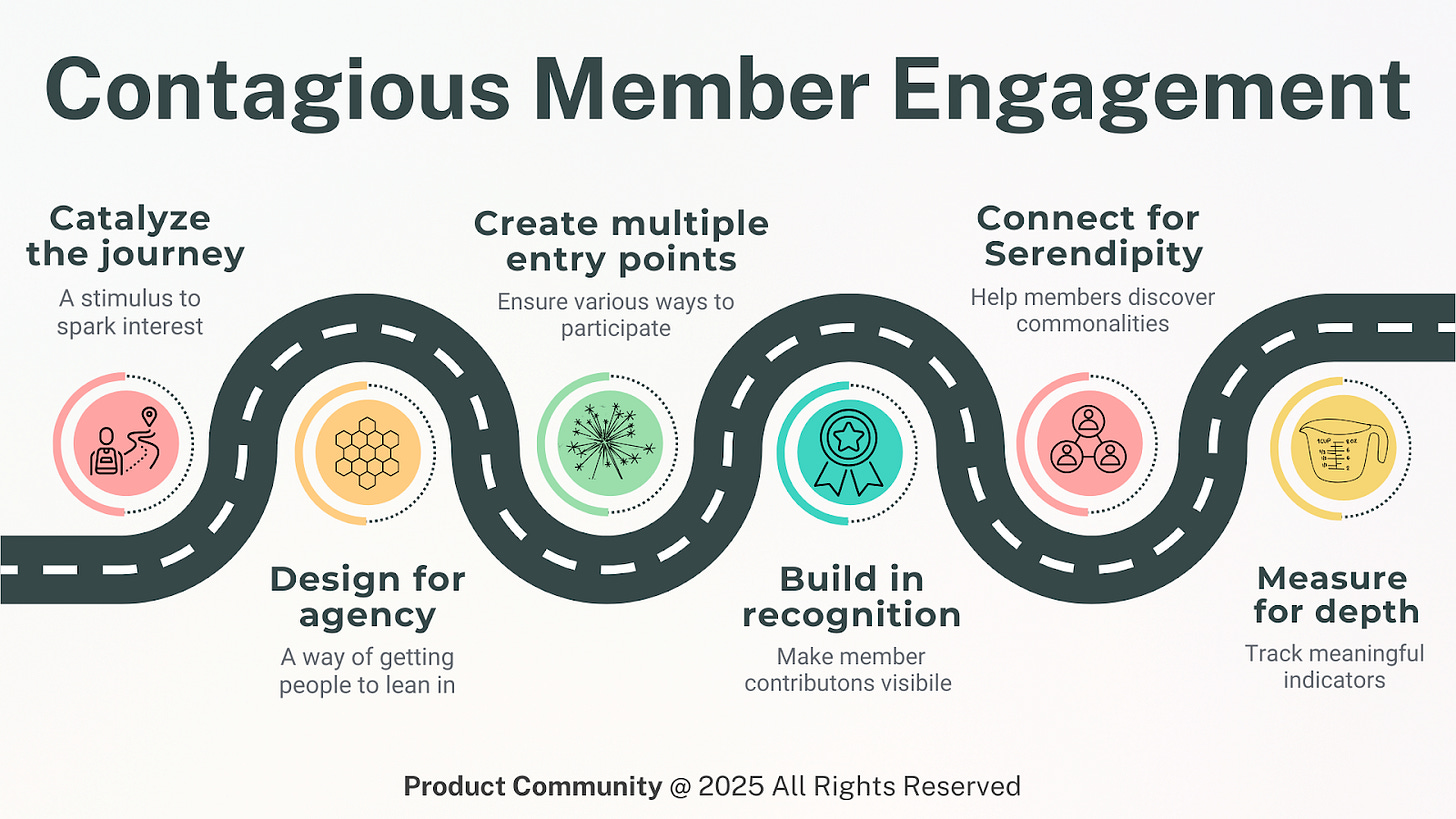Summary
Leading associations thrive on robust member engagement. It reflects our identity, creates deep and long-lasting connection, and is the impetus for participatory value creation. Engagement creates belonging. Well-designed it pulls us into spaces where we feel alive. When truly engaged, we gain access to new perspectives and feel comfortable contributing. It’s where we learn deeply, but simultaneously feel off-kilter enough to grow in ways we don’t normally anticipate.
There is always a place for short-term tactical engagement (i.e. interactive learning, community building at events, or exchanging ideas in a committee). This article goes further by digging into longitudinal engagement using value loops. Value loops anchor members in familiar settings only to challenge them to gain new knowledge from new ideas and new connections. They pull our members away from fragmented content and the start-stop nature of traditional associations. Linked together over time, value loops pull us into satisfying journeys that last a lifetime.
I lead the product community®, a product development learning community designed specifically for associations. Let’s compare ideas and build something great.
The Anatomy of a Value Loop
“[A]lignment is built on a positive feedback loop between membership, revenue, and governance. Our civic lives can be seen, not as one membership, but many memberships: We exist in overlapping webs of neighborly, communal, religious, and municipal association. When civic life is in a virtuous cycle, the groups exist for the benefit of their members, the members contribute the foundational source of revenue for the groups, and the members decide on each group’s direction. These virtuous cycles can be realized both independently — within particular groups doing their thing — and interdependently, throughout entire civic ecosystems.”
Sam Pressler
A value loop is an iterative system where member engagement and association as organization benefit by continuously reinforcing each other through authentic participation and shared contribution. Unlike traditional linear value propositions where associations deliver services to passive consumers, value loops create dynamic exchanges where members both receive and generate value, strengthening their connection to the association and each other with each iteration.
Two features differentiate value loops from standard engagement: they push us out of our comfort zones and they continue perpetually. Value loops operate on several key principles that distinguish them from conventional association programming:
Reciprocal Exchange. Members don't just consume content or services, they actively contribute expertise, insights, and resources back into the system. This creates a sense of ownership and investment that deepens over time.
Iterative Enhancement. Each cycle builds on previous interactions, creating increasingly sophisticated and personalized value. A member's participation in one activity informs and improves their experience in subsequent engagements.
Peer-to-Peer Connection. Rather than hub-and-spoke communication centered on the association, value loops facilitate direct member-to-member relationships, creating distributed networks of mutual support and collaboration.
Emergent Communities. As members engage more deeply, natural affinity groups form around shared interests, challenges, or goals, creating smaller, more intimate communities within the larger organizational structure.
What makes engagement contagious is the ongoing nature of value loops. Think of the momentum of three basic loops: one for onboarding, one for the sheer diversity of engagement possibilities (see graphic and language on member journey below), and one for the amplification effect of working experiencing loops in a social context.
Why Traditional Approaches Fall Short
The siloed approach treats member engagement as a series of discrete transactions: attend this webinar, read this publication, use this service. Each interaction stands alone, requiring the association to constantly re-prove its value while members remain largely passive recipients.
This creates several problems: Members develop transactional relationships rather than emotional investment. The association must continuously generate new content and services without leveraging the collective wisdom of its membership. Engagement remains surface-level because interactions don't build on each other meaningfully.
Overall, serial connection wanes and the association becomes dispensable. Value loops – designing for deep and long lasting engagement – help shift our identity and the value we offer toward indispensability. Membership becomes an outcome of great experience as opposed to a Costco card that provides access to the club and discounts to commoditized value.
Let’s look at what it might look like in practice.
Examples of Value Loops in Action
“The healthiest gardens aren't monocultures; they’re better off with different varieties that complement and strengthen each other. Your communities work the same way. They bring together different types of people who each contribute something unique to the ecosystem. Your quiet observers are just as valuable as your active participants.”
Laura Zug
I’ve written a lot about learning pathways, stackable experiences, cohorts, and the importance of leveraging value to create community. The idea of value loops builds on these concepts by stressing peer engagement by members who have the agency to be contributors and participators not passive consumers of general content. Value loops are momentum builders. This helps us build and sustain communities that are relevant, practical, and helpful. Here are a few examples of value loops for associations:
The Exchange Loop: A professional development program where members not only attend learning sessions but also contribute case studies, facilitate peer discussions, and mentor newcomers. Each member's participation enhances the resource pool for future participants while deepening their own expertise through teaching and reflection.
The Incubator Loop: Members submit industry challenges they're facing, collaborate in small teams to develop solutions, and share results with the broader membership. Successful solutions become part of the association's knowledge base, with contributors recognized as thought leaders who then attract new collaborators for future challenges.
The Multiplier Loop: Rather than traditional one-on-one mentoring, create cohort-based programs where experienced members guide groups of newcomers through structured challenges. Mentees eventually become mentors, while original mentors develop leadership and facilitation skills. The program continuously evolves based on participant feedback and emerging industry needs.
The Regional Loop: Local chapters don't just host events, they identify regional challenges, mobilize member expertise to address them, and share learnings with other regions. Successful initiatives get adopted and adapted across the network, while contributing regions gain recognition and attract new members who want to be part of meaningful change.
The Co-Creation Loop: Instead of staff-generated publications, members collaborate on research projects, white papers, and best practice guides. Contributors gain visibility and credibility while the association benefits from authentic, practitioner-driven content that resonates more deeply with the membership.
These aren’t the only types of value loops, but they are sufficient as conceptual frameworks and to help get your association in the game. Let’s look at some design principles.
Value Loop Design Principles
“People don’t join networks, platforms, or customer groups based exclusively on the economic value of individual features offered to them. They join in significant part because they want to be part of something: a culture, community, a crowd, a conversation. The power of a network is not just its size but its ability to make us feel connected to each other — to feel like we belong.”
Roger Martin
Successfully designed and implemented, value loops operate as engines of connection. Like pathways, there is some logic and design to what we consume and how we contribute. The magic comes in peer engagement and tight loops of sub-communities around niche topics. These compelling problems to be solved help create meaningful, powerful, and long-lasting social connections. This alone can push us as individuals and like-minded peer teams to sustain the value loops over time.
Start with Member Agency. Design systems that position members as active participants rather than passive recipients. Ask what they can contribute, not just what they want to receive.
Create Multiple Entry Points. Not every member will engage the same way. Provide various ways to participate – from heavy involvement to lighter contribution – ensuring everyone can find their comfort level.
Build in Recognition and Progression. Make member contributions visible and create pathways for increasing involvement and responsibility. This satisfies the human need for growth and status while strengthening commitment.
Facilitate Serendipitous Connections. Design touch points that help members discover unexpected commonalities and collaboration opportunities. The most powerful value often emerges from unplanned interactions.
Measure Relationship Depth, Not Just Activity. Track indicators of meaningful connection – repeat collaborations, peer referrals, content sharing, and voluntary leadership – rather than just attendance or usage metrics.
The goal, in part, of value loops is creating an indispensable contagion. Here are a few implementation strategies to get you started. First. begin by identifying existing member expertise and interests through surveys, interviews, and observation of authentic conversation patterns. Look for opportunities to transform one-way programming into collaborative experiences.
Next, pilot small-scale value loops with highly engaged members who can serve as champions and provide feedback. These early adopters often become the nucleus for broader community formation. It’s also important to invest in platforms and processes that make contribution easy and rewarding. This might include collaboration tools, recognition systems, and streamlined ways for members to share resources and expertise. Finally, train staff to facilitate rather than control. The association's role shifts from content creator to community enabler, requiring different skills and and evolved mindsets.
Contagious Growth
“Community isn’t a tactic. It’s a growth engine disguised as belonging.”
Joshua Zerkel
When value loops work effectively, they create a virtuous cycle of engagement. Members who contribute feel more invested and connected. Their contributions attract and inspire others to participate. The collective intelligence of the community grows, making membership more valuable for everyone. This increased value attracts new members while retaining existing ones, creating sustainable growth built on authentic community rather than constant acquisition.
The result is an association that becomes increasingly indispensable to its members, not because of what it provides, but because of what the association enables members to create together as a community.
I lead the product community; we are a learning community because we believe great relationships help us create the value our members want. Remember, product-led growth fuels connection. Join the product community and flip your destiny.
About the Author
James Young is founder and chief learning officer of the product community®. Jim is an engaging trainer and leading thinker in the worlds of associations, learning communities, and product development. Prior to starting the product community®, Jim served as Chief Learning Officer at both the American College of Chest Physicians and the Society of College and University Planning. Please contact me for a conversation: james@productcommunity.us








